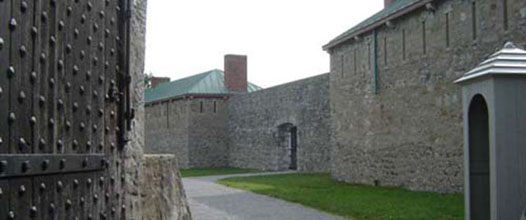Home | Places to Explore | Historic Destinations
Fort Erie
A Plaque inside Fort Erie reads:
Three fortifications occupied this site. The first (1764-1779) and second (c. 1783-1803), located at lower levels, were abandoned when ice and water inundated the works. The third Fort Erie, built between 1805 and 1808, was repaired in January 1814 but was captured by an invading American army in July of that same year. The Americans used it as a base for subsequent operations, retreated here after their defeat at Lundy's Lane, survived a siege by the British in August and September, and destroyed the fort on November 5, 1814. It was rebuilt by the Niagara Parks Commission in 1937-1939.
The Pictorial Guide to the Falls of Niagara, 1840, Manual for Visitors states the following:
"....at the efflux of the river, and on the Canada side, stand the ruins of Fort Erie. This fortification, originally built by the French about a century ago, was a small but extremely well planned and constructed post, and must have been considered of no little importance by those who were at the trouble of its erection.
All its defences were laid out and arranged in the exactest style of art ; and the masonry bears witness, even at this distant date, to the solidity with which it was put together The curtains and other walls were grouted with a cement of water-lime, evincing the greatest care for durability, and none for expense. The bastions were all flanked with this admirable stone work, and the whole surrounded by a deep ditch, further strengthened by pointed stakes, firmly and thickly planted in the fosse, inclining outward, and rising just above the water, with which it was nearly filled.
The fort was evidently designed by an able engineer, and might have been regarded as a miniature model of military architecture. Every avenue of approach, was enfiladed or exposed to a cross fire, and nothing seems to have been omitted that could contribute to the annoyance of a besieging foe, or the protection of its little garrison. By the Indians, it must have been deemed impregnable.
Fort Erie was, during the late war, the scene of some of the most memorable exploits of the Republican army. It was surrendered on the third of July, at the first summons, to General Brown who, with a force of five thousand men, invaded Canada in 1814, by Major Buck, the officer in command ; and the British garrison, consisting of one hundred and thirty-seven men of the Eighth, or King's Regiment, became prisoners of war.
The troops under General Brown, advancing upon Fort George, and fighting the celebrated battles of Chippewa and Niagara, fell back upon this point, and sustained a siege, remarkable for the gallantry with which it was pressed and repelled. Subsequently, the British forces having retired to winter quarters, the fort was abandoned and demolished, the campaign ended, and the American army having gained nothing but glory by the invasion, returned to their own country.
The fortification is now entirely in ruins, deserted and desolate ; but its ancient defences may still be traced out, and the little hillocks that dot the plain below, each marking a soldier's grave, -attest the obstinacy with which the attack was urged, and the assault repulsed. "

